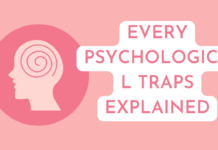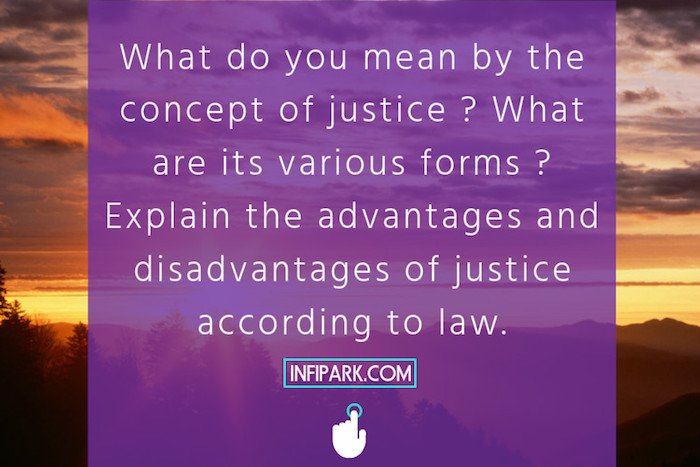What do you mean by the concept of justice ? What are its various forms ? Explain the advantages and disadvantages of justice according to law.
Ans. Meaning of the Concept ofJustice-It is to be noted that Acquinas and Solmond both are of the opinion that justice is one of the goals of law. For them, it is indeed a logical part of very conception of law. Acquinas following Augustine is of the opinion that an unjust law is no law. For Salmond law is those principles which applied by the State in the administration of justice.
The term “Justice” has been defined by the eminent jurists as fol-lows —
1. According to Ulpian, “Justice is the constant and perpetual will to render to everyone that to which he is entitled.”
2. According to Cicero, “Justice is the disposition of human mind to render, to everyone his due”.
3. According to Acquinas, “It is a habit whereby a man renders to each his due by a constant and perpetual will.”
4. According to Friedmann,” ‘Justice’ as a generally valid con-cept, is formal, in the sense that it is the goal to which every legal order aspires as a “purposeful enterprise and procedural, in the sense that the Aristotelian notion of”equality for equals” implies a minimum machinery of justice and third party intervention.”
5. According to Rawls, Justice is composed of two cardinal prin-ciples. In the words of Rawls—The first statement of the two principles reads as follows—
Firstly—Each person is to have an equal right to the most extensive basic liberty compatiable with a similar liberty to others.
Secondly—Social and economic inequalities are to be arranged so that they are both (a) reasonably expected to be to every one’s advantage, and (b) attached to the positions and offices open to all.
These principles need not, however, be accorded equal weight in social policy—the first principles is to be given priority over the second.
In short, Rawls regards “justice as fairness”. In the universal sense the concept of justice is devoid of ideological content. It can be used in a wider or a more restricted sense. In a wider sense, such as used by Acquinas in his contention that an unjust law is no law, justice appears to be roughly synonymous with morality. However, in narrower sense, as used in the expressions ‘Court of justice’, ‘natural justice’ and ‘denial of justice’ the term refers to but one area of morality. “Justice is not something”, which can be captured in a formula once and for all; it is a process, a complex and shifting balance between many fac-tors, including equality”. The master mind of Aristotle is of the opinion that justice consists of “some sort of equality”. In dealing with particular justice as distinct from “universal justice” he distinguished between ‘dis-tributive’ and ‘corrective justice’.
Various Forms of Justice—Generally speaking, justice may be defined in the following different forms —
I. Natural, Conventional or Legal Justice —According to Aristotle, justice may be divided into two kinds — natural and conven-tional. Natural justice is universal. Natural or normative justice is served by natural or moral law. Natural justice is justice itself, in deed and truth. It is justice in its absolute and perfect sense and conventional justice is that which binds because it was decreed by a particular authority. Thus, the precept of natural justice is that I must return what has been lent to me, whereas it is conventional justice that lays down whether the period of prescription is six or sixty years. Natural justice is linked with ‘divine reason’. Natural justice is thus, the gift of God. And, therefore, everyone is bound to act in accordance with it. Underlying inspirational feeling be-hind natural justice is divine spirit. Medium of legal justice are Courts which impart justice according to laws in force. This is not the gift of God.
2. Distributive and Corrective Justice —Again Aristotle has di-vided justice into Distributive and Correctional Justice. Distributive jus-tice is based on the principle that there has to be equal distribution among equals. Equal things shall be given to equal persons and unequal things to unequal persons. In other words, it works to ensure a fair division of social benefits such as rights, powers, duties and burdens among the members of the community. To put it other way, there should be a just allocation of advantages and disadvantages among the members of the community or the group. Equal distribution among equals means that according to a given criterion of discrimination unequals cases are to be treated in a different manner. Herbert Hart has sought to limit the concept of distributive justice to cases of arbitrary discrimination. To him, the general principle latent in the diverse application of the idea of justice is that individuals are entitled in respect to each other to a relative position of equality or inequality.
Thus, according to this view of Hart, a just law would be one which treats like situation alike; an unjust law allocate rights and duties un-equally without a plausible ground. Classical definition of distributive justice was given by Aristotle. Accordingly, “injustice arises when equals are treated unequally” and also when unequals are treated equally.
When the balance or the equilibrium is distributed or is upset among the members of the society as a result of the action of some persons “corrective justice” steps in to correct the imbalance. In other words, `corrective justice’ operates when a norm or rule of “distributive justice” has been violated by a member of the community. It will then become necessary to make ainends for a wrong or deprive a party of an unjustified gain. If a member of the community has encroached upon the rights, privi-leges or property of another member, corrective justice will return to the victim that which belonged to him or compensate him for the loss. Thus, if A wrongfully seizes B’s property, corrective justice acts to restore the status quo by compelling A to make restitution. Corrective justice is gen-erally administered by a Court or any other organ invested with judicial or quasi-judicial powers and mostly applied in the areas of contracts, torts and crimes.
Dealing with ‘distributive’ and ‘corrective justice’ Salmond says, Justice, then, in its distributive aspect serves to secure, and in its corrective aspect to redress, the balance of benefits and burdens in a society.
3. Social Justice—According to Rawls, social justice is a process whereby major social institutions distribute fundamental rights and duties and determine the division of advantages from social cooperation. By major institutions he means “political constitution and the principal economic and social arrangements”. He says that the legal protection of free-dom of thought and liberty of conscience, competitive markets, private property in the means of production and the monogamous family are examples of major social institutions. In his view social justice depends on-1. How fundamental rights and duties are assigned, and 2. on the economic opportunities and social conditions in the various sectors of society.
Social justice consists of diverse principles essential for the orderly growth and development of personality of every citizen. Social justice is thus, an integral part of the concept of justice in generic sense. Justice is the genus of which the social justice is one of its species. Former Chief Justice of India, Justice K. Subba Rao says that “social justice is one of the disciplines of justice arid the discipline of justice relates to the soci-ety.” In common parlance social justice means justice with every section or class of society. Every class of society is not equal. Biggest reason for non equality are the deep inequalities in the society. Not only they are pervasive, but they affect men’s initial chances in life; yet they cannot possibly be justified on an appeal to notions of merit or desert. It needs, however, be noted the concept of social justice have varied with age and time.
On account of these inequalities the society is divided between `haves’ and ‘have-nots’. A poor person is not able even to fulfil his basic necessities of life. He does not get an equal opportunity to develop its personality. Hence, the first and the formost job of social justice is to draw its attention towards pervasive inequalities pervading the basic structure of the society and to eradicate them.
The Supreme Court of India in its judgment dated 16th November, 1992, declared 27% of reservation to socially and educationally backward classes of citizens as valid. It however, declared 10% additional reserva-tion, as provided in modified office memorandum dated 25th September, 1991, to other economic backward sections of people as illegal and invalid. The Supreme Court of India while accepting 27% of the reservation made it clear that reservation is not permissible in those appointments which require special and technical qualifications.
Similarly, in order to make the concept of social justice more mean-ingful the Supreme Court of India in Mohini Jain Vs. State of Karnataka, declared that the “right to education” is, therefore, concomitant to funda-mental rights enshrined in Part III of the Constitution. The State is under a constitutional mandate to provide educational institutions at all levels for the benefit of citizens.
Assigning the reason for this ratio in above case, the Supreme Court observed—The fundamental rights guaranteed under Part 111 of the Constitution of India including the right to freedom of speech and expression and other rights under Art. 19 cannot be appreciated and fully enjoyed unless a citizen is educated and is conscious of his individualistic dignity.
4. Justice According to Law—One of the essential function of state administration is the administration of justice. As has already been stated law is an instrument of justice and administration ofjustice is made through Courts. Courts are not only Courts of law but they are Courts of justice as well. Salmond defines law in terms of purpose. Salmond defines law as the body of principles recognised and applied by the State in the administration of justice. Making it more clear he says that law is made of those principles that Court of justice recognise and act accordingly. Justice as such cannot be achieved without or outside the rule of law. To him “justice is the end of law”. According to Salmond, one of the functions and pur-poses of law is ‘justice’ and therefore, it follows that justice should be done according to law. It is the logical part of the very notion of law.
Advantages of Justice —
According to Salmond, justice according to law has three distinct advantages —
I. A legal system ensures uniformity and certainty in the adminis-tration of justice. Law as a guide to conduct would become utterly futile if it were not known to the people. The judges, when the law is certain, know what the rules are and, therefore, can enforce them uniformly, and the citizens being certain of the law can shape and mould their conduct ac-cordingly.
2. Law, it is said, is a guarantee of impartiality in the administration of justice. If judges are to decide according to law that predetermined legal norms and principles, the chances of their yielding to personal motives are almost nil, for a vigilant public can easily point out the departure from the rule of law and can take the steps to redress the mischief.
3. Coke is of the opinion that “the wisdom of law is wiser than any man’s wisdom. And, therefore, the third reason why justice should be according to law is that the judge by availaing himself of the experience and the wisdom of the community as recorded in the law is likely to be less falliable and is more likely to come to a sound conclusion that if he has to rely solely on his own wisdom and sense of right and justice.
Disadvantages of Justice According to Law—
According to Salmond, the law is without doubt a remedy for great evils, yet it brings wilhit evils of its own. It is equally true to “justice according to law”. It has its disad-vantages noted as follows —
I. One of its usual defect of justice according to law is that, it makes the law rigid with the result it is not able to conform to the require-ments of unforeseen cases.
2. When a judge is bound to apply a rule of law, he is left with no rational discretion. It is possible that a rule may not be in public interest, it is just possible that it may be based on wrong fact and a deviaion is called for.
3. Law tends to become conservative. With the progress in the society, peoples attitude and approach towards a thing also change. With the march of time people’s views about truth and justice also undergo a change.
4. It has been proved that in these days of welfare state Courts have generally failed to live to the ground realities, needs and expecta-tions of the society.
5. Another vice of law is its formation adn technicality. Judge give undue importance to legal technicalities.
6. Finally, the complexity of law these days is a common evil.










